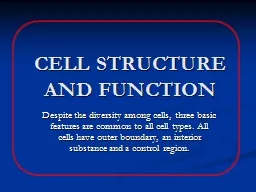

CELL STRUCTURE AND FUNCTION Despite the diversity among cells three basic features are common to all cell types All cells have outer boundary an interior substance and a control region CELL STRUCTURES ID: 765305
Download Presentation The PPT/PDF document "CELL STRUCTURE AND FUNCTION" is the property of its rightful owner. Permission is granted to download and print the materials on this web site for personal, non-commercial use only, and to display it on your personal computer provided you do not modify the materials and that you retain all copyright notices contained in the materials. By downloading content from our website, you accept the terms of this agreement.
CELL STRUCTURE AND FUNCTION Despite the diversity among cells, three basic features are common to all cell types. All cells have outer boundary, an interior substance and a control region.
CELL STRUCTURES
PLASMA MEMBRANE Composition: phospholipid bilayer with embedded proteins.Function: selective passage of molecules into and out of cell
NUCLEUS Composition: nuclear envelope surrounding nucleoplasm, chromatin and nucleolusFunction: storage of genetic information, controls metabolic functioning and structural characteristics of the cell.
RIBOSOMES Composition: protein and RNA in two subunitsFunction: Protein synthesis
ENDOPLASMIC RETICULUM Composition: membranous saccules and canalsFunction: synthesis and /or modification of proteins and other substances, and transport by vesicle formation
GOLGI APPARATUS Composition: stack of membranous sacculesFunction: Processing, packaging, and distribution of molecules
VACUOLE AND VESICLE Composition: membranous sacFunction: storage and transport substances
LYSOSOME Composition: membranous vesicle containing digestive enzymesFunction: intracellular digestion
MITOCHONDRION Composition: inner membrane (cristae) within outer membraneFunction: cellular respiration
CYTOSKELETON Composition: microtubles, actin filamentsFunction: shape of the cell and movement of its parts.
STRUCTURE OF THE CYTOSKELETON
CILIA AND FLAGELLA Composition: 9 + 2 pattern of microtubulesFunction: movement of cell
CENTRIOLE Composition: 9 + 0 pattern of microtubulesFunction: formation of basal bodies
CHROMOSOME Chromosomes are rod-shaped structures made of DNA and proteins.
CHROMOSOME Chromatid- the strand of a chromosome that becomes visible during meiosis or mitosis. Chromatin – the less tightly coiled DNA-protein complex Centromere – the region of the chromosome that holds the two sister chromatids together during mitosis.
SEX CHROMOSOMES & AUTOSOMES Sex chromosomes are chromosomes that determine the sex of an organism, and they may also carry genes for other characteristics. In humans, sex chromosomes are either X or Y. XX for female XY for male The autosomes are all the other chromosomes in an organism except for sex chromosomes. In humans two of the 46 are sex chromosomes, and the remaining 44 chromosomes are autosomes.
HUMAN KARYOTYPE
HISTONE AND NON-HISTONE The DNA in eukaryotic cells wraps tightly around proteins called histones. Histones help maintain the shape of the chromosomes and aid in the tight packaging of DNA. Nonhistone proteins are generally involved in controlling the activity of specific regions of the DNA
CELL CYCLE The cell cycle is an orderly set of stages that take place between the time a cell divides and the time the resulting daughter cells also divide.
CELL CYCLE STAGES Interphase -the cell carries on its regular activities. The three stages: G1 phase S phase G2 phase. Mitotic Stage Stages of mitosis: karyokinesis (division of the nucleus) cytokinesis (division of the cytoplasm).
DNA REPLICATION STAGES: The old (parental) DNA strands unwind and “upzip” New complementary nucleotides pair with the nucleotides in the old strands. A pairs with T and C pairs with G. The enzyme DNA polymerase joins the new nucleotides forming new (daughter) complementary strands. When replication is complete, the two double helix molecules are identical.
PROTEIN SYNTHESIS Is the formation of proteins by using information contained in DNA and carried by mRNA
PROTEIN SYNTHESIS TRANSCRIPTION- is the process of forming a nucleic acid by using another molecule as a template; particularly the process of synthesizing RNA by using one strand of a DNA molecule as a template. TRANSLATION- refers to the portion of protein synthesis that takes place at ribosomes and that uses the codons in mRNA molecules to specify the sequence of amino acids in polypeptide chains.
CONTROL OF CELL DIVISION In eukaryotes, proteins regulate the progress of cell division at certain checkpoints.
CELL GROWTH CHECKPOINT 1. Cell Growth Checkpoint. Proteins at this checkpoint control whether the cell will divide. Hint: if the cell is healthy and has grown to a suitable size during G1 phase, protein will initiate DNA synthesis (S phase). If conditions are not favorable for DNA synthesis, the cell cycle will stop at this point.
DNA SYNTHESIS CHECKPOINT 2. DNA Synthesis (G2) checkpoint. DNA repair enzymes check the results of DNA replication. If this checkpoint is passed, proteins will signal the cell to begin the molecular processes that will allow the cell to divide mitotically.
MITOSIS CHECKPOINT 3. Mitosis checkpoint. If a cell passes this checkpoint, proteins signal the cell to exit mitosis. The cell enters into the G1 phase, the major growth phase of the cell cycle, once again.
PROKARYOTIC CELL DIVISION Most prokaryotes reproduce by binary fission, in which two identical cells are produced from one cell.
EUKARYOTIC CELL DIVISION In eukaryotic cell division, both the cytoplasm and the nucleus divide. There are two types of cell division in eukaryotes – mitosis and meiosis.